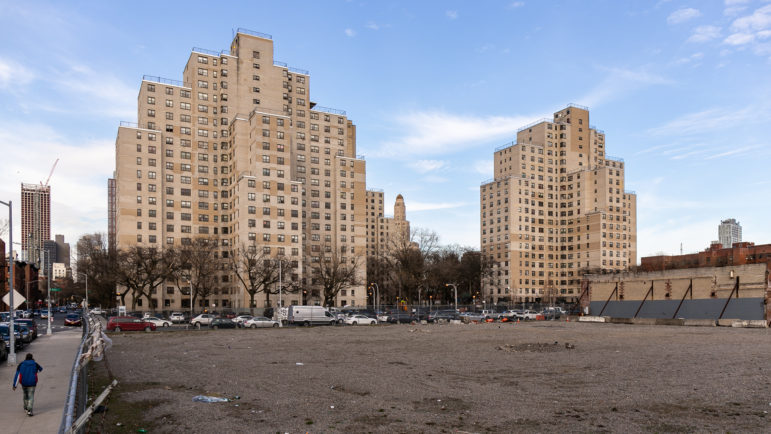“It is time for New York to meet its public housing needs. It has the land. The technical ability to restore and replace NYCHA’s housing stock to meet tenant needs and low-carbon performance is there.”

Adi Talwar
A view of NYCHA Wyckoff Gardens from the intersection of Butler Street and Nevins streets.In her annual State of the City speech this week, City Council Speaker Adrienne Adams proposed building new buildings on New York City Housing Authority property. While the idea is still embryonic, if done right, it could transform low-income housing in the city.
It is important to realize that NYCHA is unlike any other public housing in the United States. Despite unending bad publicity, NYCHA is vital to New York City. The authority has 179,000 units in 335 projects. The second largest public housing authority, Puerto Rico, has 56,000 units and the third largest, Chicago, only 17,500. With more than 535,000 residents, NYCHA houses more people than the entire city of Atlanta (496,000 residents). As of 2017, NYCHA’s vacancy rate was lower than 1 percent; in the same year the Chicago Housing Authority’s rate was 18 percent. The city’s waiting list for an apartment is over 160,000 applicants long. While other cities have demolished thousands of apartments, NYCHA has torn down only one of its developments, the 368-unit Prospect Plaza in Ocean Hill, in 2014.
NYCHA actually predates the 1937 Federal Housing Act, which brought Washington into building low-income homes. Much of what is now found to be objectionable about NYCHA, like the poor quality of the buildings and the super-blocks, were imposed by subsequent federal legislation. The permitted cost of construction was pegged at such a low level that NYCHA appealed to New York State for additional funding. No other state at that time stepped up to meet that need. Moreover, those buildings built to be cheap are now up to 85 years old and in desperate need of major repairs.
The super-block emerged for other reasons. During the first half of the 20th century there was an almost universal horror of slums and residential density. Especially in New York, the demolition of slums and the creation of healthy housing was a major progressive priority. The tower-in-the-park and “light, air and open space” were seen as solutions to save slum dwellers.
The aversion to density resulted in a near obsession by NYCHA planners with open space. The NYC 1901 Building Code set 70 percent as the maximum allowed site coverage by new construction. NYCHA buildings typically covered only 25 percent of the super-block sites. If the slums often had upwards of 1,000 people per acre, NYCHA designers aimed for only 250 people per acre.
The goal was low density. How to program and maintain all that open space then became the dilemma for underfunded managers and tenants. On the other hand, that underused open space is an asset if NYCHA sought to build new, low-income housing.
How might NYCHA start building again? As the speaker proposes, a new 21st century building could be built on open space, say in a parking lot. The tenants of an existing building could be moved in and then that building demolished. On the remaining foundations, a new building could be constructed to take up the residents of yet another building, and so on. All the existing open space, except that of the first new building, would remain. Zero land cost would greatly reduce funding needs.
An even newer possibility is the cladding of existing building facades with panels incorporating waterproofing, insulation and even heating and cooling elements. The system allows residents to stay in place while the work is done. The retrofit creates a high level of energy performance, thus reducing carbon emissions. A combination of this retrofit approach with the replacement of unsuitable buildings could make NYCHA fully compliant with the city’s projected sustainable future.
Besides the benefits of improved energy and emission performance, replacing and cladding NYCHA’s worn-out existing structures would make it possible to reframe NYCHA’s urbanistic relationship to the city. Building siting and material choices could radically change the relationship of the super-blocks to the rest of the grid. Before federal funding was ended in the 1970s, Battery Park City and Roosevelt Island pointed in a new direction for public housing. Lessons learned there could be brought back to the super-block.
To build again, one critical rule must be observed: NYCHA tenants cannot be displaced. Moving existing tenants from an old building into a new, modern one in the same development would be welcomed. Displacing them or setting up potential conflicts with mixed public/market housing will face resistance. Mayor Bloomberg’s attempt at that near the end of his term did not go well.
The most efficient means to financing new construction is with public funding—city, state and federal. The reason NYCHA succeeded so well in the mid-20th century was public funding. The funding was intentionally parsimonious but it was straightforward.
It is time for New York to meet its public housing needs. It has the land. The technical ability to restore and replace NYCHA’s housing stock to meet tenant needs and low-carbon performance is there. Speaker Adams, with the support of Mayor Adams and Gov. Hochul, is supplying the leadership. The secret to “the City of Yes” will be to keep what is public public.
Charles Lauster is a New York architect.









2 thoughts on “Opinion: Building Again at NYCHA”
New York has a lot of potential for better exploitation and development.
The statement you provided seems to express a call to action for New York to address its public housing needs by utilizing available land and technical expertise to both restore and replace the New York City Housing Authority’s (NYCHA) housing stock. Additionally, the statement emphasizes the importance of ensuring that the housing developments meet the needs of tenants while also achieving low-carbon or environmentally sustainable performance.